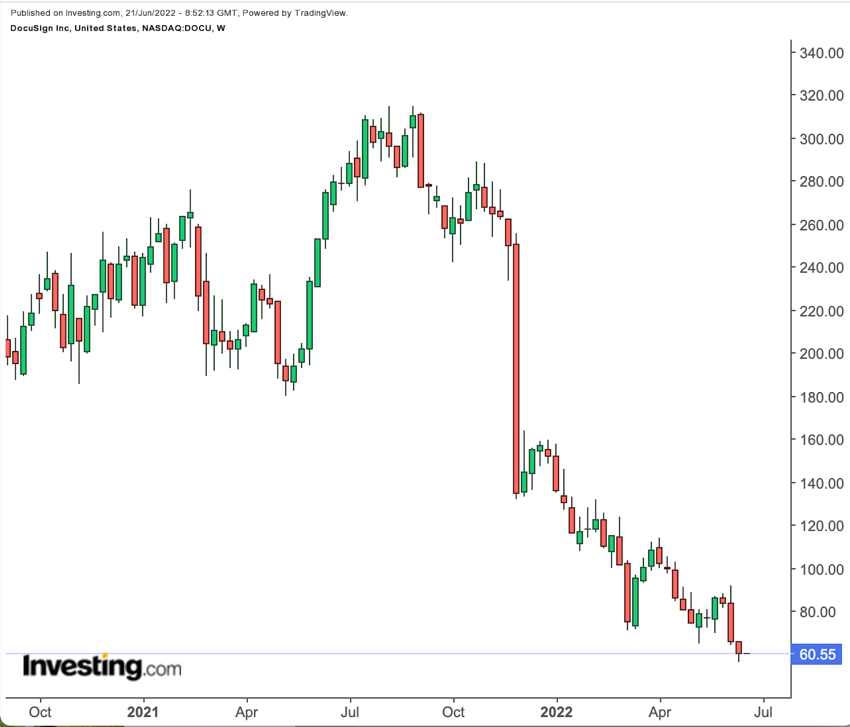This article was written exclusively for Investing.com
So-called “pandemic winners” have been hammered over the past year, even relative to plunging broad market indices. DocuSign (NASDAQ:DOCU) has been no exception.
In September, the electronic signature software provider traded at over $300. It closed Friday just above $60. Among more than 700 large-cap stocks (market cap over $10 billion), only eight have fallen further from their 52-week high.
At the very least, that kind of decline makes shares of the e-signature solutions provider intriguing. Even accounting for the danger of “anchoring bias”—which we've discussed in the context of other fallen angels like Coinbase (NASDAQ:COIN)—an 81% fall suggests that at least the stock might be cheap. So too does the erasure, incredibly, of nearly $50 billion worth of equity value in less than ten months.
But intriguing isn't the same as compelling. Looking at DOCU with fresh eyes, the case for a long position isn't all that attractive—at least not yet. There are very real concerns and very real challenges here. The size of the sell-off to this point isn't relevant to those risks—and it certainly doesn't offset them.
DOCU Stock Isn't Cheap
One big problem with buying the dip (or the plunge, as it were) is that even down 81% DocuSign still isn't cheap from a fundamental perspective.
At first glance, admittedly the San Francisco, US-based software provider looks like it's offering value. For fiscal 2023 (ending January), DocuSign is guiding for revenue just shy of $2.5 billion. With an enterprise value of $12 billion, DocuSign's price-to-revenue multiple is below 5x—seemingly attractive in a software space where many companies received double-digit multiples, and some still do.
Based on its adjusted figures, meanwhile, DocuSign is nicely profitable. Trailing 12-month adjusted EPS is $1.92, suggesting a price-to-earnings multiple of just 32x. Trailing 12-month free cash flow—without adjustments—is just shy of $500 million, meaning DOCU trades at 24x free cash flow. That's a multiple that implies little growth going forward.
But both metrics have significant problems. 5x revenue only 'seems' cheap because, in a roaring bull market, investors were paying 15x or 20x. Those days are over—most likely for quite some time.
That aside, investors need to value a stock based on profits and cash flow. For DocuSign, neither is quite as impressive as it appears, for one key reason: stock-based compensation.
Like a lot of tech companies, DocuSign pays its employees with a good deal of stock. And like nearly all tech companies, DocuSign excludes that stock issuance from its adjusted earnings figures.
But stock-based comp is a real expense. And for DocuSign, it's a significant expense. Over the past four quarters, DocuSign has booked $437 million in stock-based compensation. Its adjusted operating income over the same period is $428 million.
If an investor accounts for the issuance of stock—issuance which dilutes existing shareholders—DocuSign over the past year has been an unprofitable business. The $500 million in free cash flow too nearly disappears when considering stock issuance (which, as a non-cash expense, isn't reflected in cash flow calculations).
In that context, a $12 billion enterprise value by no means appears inexpensive.
Concerns Looking Forward
To be fair, investors need to look not only at the fundamentals—but to look forward. High-growth stocks don't need to be generating significant, or any, profit right now to be an attractive investment going forward.
The problem for DocuSign is that it's not going to be a high-growth company in the near future. First quarter revenue did increase 25% year-over-year, on top of 58% growth the year before. But the company's full-year guidance, even at the high end, suggests only 18% growth for all of fiscal 2023—and just 16% over the remaining three quarters.
The news is more concerning in terms of billings. Billings account for the amount of new business coming on board by adjusting for deferred revenue and other factors. (For a subscription business, a good chunk of a revenue in a period comes from recognizing sales that occurred in the past.) DocuSign's full-year guidance calls for billings growth of just 7% to 8%—and a roughly 5% increase for the last three quarters of FY23.
The steep decline in DOCU stock has come because the underlying growth of the business has decelerated dramatically. That's why earnings reports have been such a problem for the stock. DOCU fell 42% after the Q3 report in December, 20% after the Q4 release in March, and then 32% (over two sessions) after this month's Q1 numbers.
Each quarter has shown another leg down in the company's growth. So, while broad market weakness has contributed to the decline in DOCU stock since September, much of the selling is coming in response to the company's actual performance.
Given the combination of minimal 'true' profitability and sharply slowing growth, it's no surprise that shares have sold off. Nor does that sell-off necessarily create a buying opportunity.
The Case for Buying DocuSign Stock
To be fair, all hope is not lost. Revenue and billings guidance is disappointing, certainly. But DocuSign is comparing against an impressive FY22, and there's still a long-term opportunity. DocuSign's Agreement Cloud expands beyond e-signatures into “contract lifecycle management,” and underpins an estimated $50 billion annual revenue opportunity.
Meanwhile, even DocuSign's own chief executive officer has admitted, more than once, that the company took its eye off the proverbial ball. The company faltered at executing on its “land and expand” strategy, in which it attracts clients and then consistently sells more and more services.
There's plenty of room for improvement on that front as DocuSign adapts to a new normal. And like a lot of tech firms, that new normal may well include lower compensation (stock-based and otherwise) which in turn helps margins.
DocuSign certainly can't be written off yet. But that's not enough to make the stock a buy. There are going to be difficult quarters ahead. We don't really know how DocuSign will perform in a recession—the company only went public in 2018—but trends like a slowing housing market presumably will provide a headwind if the macro environment deteriorates. And, at the very least, it's nerve-wracking to own a stock ahead of earnings (the next report arrives in September) when that stock has averaged a decline of over 25% following its last three releases.
Put simply, the company has a lot of work left to do, and some stumbling blocks to avoid. At the right valuation, perhaps it's worth taking on that risk. The catch is that even down 81%, DOCU stock still hasn't hit the right valuation just yet.
Disclaimer: As of this writing, Vince Martin has no positions in any securities mentioned.
***
Looking to get up to speed on your next idea? With InvestingPro+, you can find:
- Any company’s financials for the last 10 years
- Financial health scores for profitability, growth, and more
- A fair value calculated from dozens of financial models
- Quick comparison to the company’s peers
- Fundamental and performance charts
And a lot more. Get all the key data fast, so you can make an informed decision, with InvestingPro+. Learn More »
